
Discover hidden gems when you go off the beaten path with Oku Japan

First time visitors to Japan typically have Tokyo, Kyoto and Nara on their list, as these cities are well-known and contain many cultural and historic attractions. Other popular destinations include Osaka, Nagoya, Kobe and Mt. Fuji. These places are all located on the main island of Honshu.
If you’re a return traveler to the country, however, you’ll probably want to explore different areas on Honshu or perhaps head to one of the other islands like Kyushu, Shikoku or Hokkaido. In any case, you most likely have the desire to go deeper into Japan and get away from heavy tourist spots.

Take a traditional boat ride in Kurashiki. Photo by Debbie Stone

Wedding couple poses on Miyajima. Photo by Debbie Stone

Taikodani Inari Shrine’s one thousand vermillion Torii gates. Photo by Debbie Stone
Oku Japan
That’s me in a nutshell, which is why I opted to join Oku Japan’s “In the Shadow of Mountains” tour. Oku Japan is a highly reputable and respected company, offering crafted itineraries, both guided and self-guided, that encourage visitors to get up close and personal with Japanese culture, history and lifestyle.
Early on in his life, Oku’s founder Matt Malcomson made a conscious choice to avoid mainstay vacation destinations, preferring to travel off the beaten path. He discovered that his experience was richer when he took the time to explore less visited areas. The locals would take an interest in him and show more of a desire to introduce him to their way of life. It was this feeling of inclusion and immersion that he wanted others to have, which became the impetus for Oku Japan.

Guide Jun showing the region for the tour. Photo by Debbie Stone

Guide Jun striking a pose. Photo by Debbie Stone

Jizo statue. Photo by Debbie Stne
“Oku” in Japanese is a concept that is akin to “penetrating the layers of an onion.” It implies an inclination to reach the inner core. With this notion in mind, Oku Japan has created trips that “combine the simple pleasures of enjoying the hospitality of close-knit communities deep in the countryside that preserve the traditions of a not-too-distant past: their home-grown food, carefully preserved buildings, and immense pride in where they live and who they are.”
Acting responsibly as a tour company is also a core tenet of the company. It endeavors to contribute positively to each of the destinations it serves. This is especially significant for rural locales, many of which have dealt with decline and depopulation, as younger people left for the cities. Bringing visitors to these communities assists them economically and helps their society and culture to endure.
“In the Shadow of Mountains” tour, you’ll travel to towns, villages, cities and islands of western Japan, on both the Sea of Japan and the Seto Inland Sea regions. This small-group, guided, 12-day trip begins in Kyoto and ends in Osaka.

Okonomiyaki is a savory pancake dish. Photo by Debbie Stone

Rural village scene. Photo by Debbie Stone

The snake with many heads and tails! Photo by Debbie Stone
Our group of twelve hailed from the U.S., Canada and Australia. Half of us had been to Japan previously; the other six were newbies. We quickly bonded over our love of travel and interest in Japanese culture. Our curiosity was never-ending, as were our questions. Thankfully, our guide Jun was knowledgeable and had the patience of Job.
Oku’s tours emphasize traveling as the locals do with the help of public transportation. This means you’ll take various modes – trains, buses, trams, subways and even boats – to move from one place to another. Think of “Planes, Trains and Automobiles,” and you get the drift. Your feet will also get a workout, as you’ll do plenty of walking each day, anywhere from five to seven miles, often on uneven and rough surfaces with countless stairs.

View of the Seto Inland Sea with Seto Ohashi Bridge. Photo by Debbie Stone

View of Tsuwano with chairlift. Photo by Debbie Stone
Getting Around
The trains in Japan are excellent. They’re well-known for always being on time and super convenient. There are several different types: local, express, semi-express, rapid, limited express and the famous shinkansen, or bullet trains. These are the fastest trains in the country, and maybe the world. They can reach an impressive speed of nearly 200 miles per hour. You’ll feel like you’re levitating off the tracks!
I liked taking public transportation, as opposed to having a dedicated van for the group. However, this translated to spending more transportation time than I desired. I understood, however, this was necessary in order to reach some of the more remote destinations. And overall, it was worth the rewards offered by most of these locations.

You’ll take a variety of trains on this trip. Photo by Debbie Stone
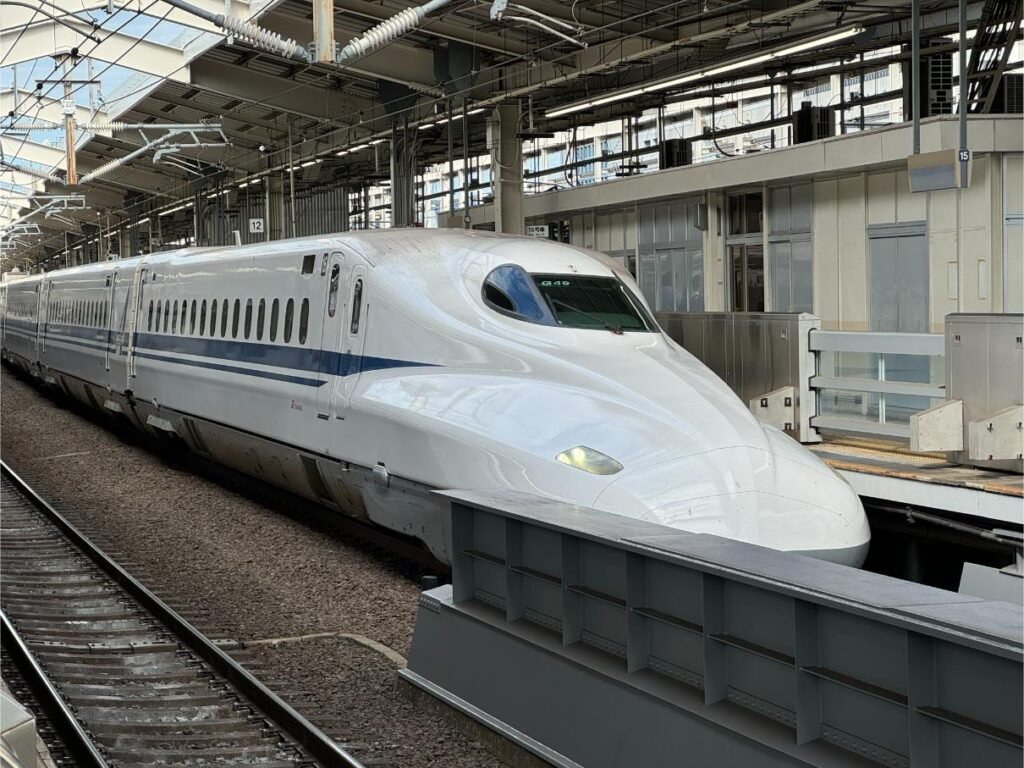
Speedy Shinkansen. Photo by Debbie Stone

Sunset over the sea. Photo by Debbie Stone

Shrine in the mountains of Yunotsu. Photo by Debbie Stone

Tsuwano scene. Photo by Debbie Stone
There was much to see and absorb during this tour, with a number of highlights that are particularly memorable. One was Kurashiki’s Bikan Historical Area, which boasts a preserved canal area dating back to the Edo Period, when the city was an important rice distribution hub. “Kurashiki” means “town of storehouses,” and you’ll see many of these former white-plastered buildings that have since been converted into museums, shops and cafes.
Often referred to as the “small Kyoto with waterways,” you’ll find this place to be charming and picturesque. The canal is line with willow trees and you can walk alongside it or take a traditional boat ride to experience the feudal atmosphere.
Jeans, Bridges & Cherry Blossoms
As you wander, you’ll notice a small alley of shops selling upscale artisan items made of denim. This is Denim Street, appropriately named, as Japan’s first line of jeans was made here in 1972. Nearby is Kurashiki Ivy Square, a collection of brick buildings covered in ivy that include a museum, restaurants and hotel. This area was the site of the first modern cotton mill in the country and the buildings were originally part of the mill in 1889.
The Kojima area of Kurashiki is another picture-pretty place, as it faces the Seto Inland Sea. We climbed to the top of Washuzan Hill for stunning views. This scenic spot is in the Seto Inland Sea National Park, the country’s first national park. The panoramic vista is spectacular, with the eight-mile-long Seto Ohashi Bridge taking centerstage. This is the world’s longest two-tiered bridge system, serving both cars and trains. It connects Honshu to Shikoku and is an architectural and engineering masterpiece.

Dinnertime! Photo by Debbie Stone

Silver mine shaft. Photo by Debbie Stone

Performance at shrine. Photo by Debbie Stone
In Omori-cho, our group took a guided tour of the town, which features several Shinto shrines and Buddhist temples, along with historical homes noted for their glazed, red tiled roofs. The main attraction here is the Iwami Ginzan Silver Mine. This UNESCO World Heritage Site was the largest silver mine in Japanese history, flourishing from the 16th to the 20th century. It was discovered by a merchant, who, from his boat, spotted a temple nestled in the mountain. He went to find it and on his return trek, he spied some shining pieces, which turned out to be silver. The rest is history.
We rambled around old mining sites and miners’ settlements, and were able to go inside one of the major remaining silver mineshafts, Rugenji Mabu. Our guide told us about the mining techniques used back then and painted a picture of a miner’s life. She explained that males, ten years and older, worked in the mine. Only males were allowed inside, as the god of mines didn’t like women in there and the people didn’t want to anger the deity for fear something bad would happen.
The miners were typically small men, as they needed to be able to get into narrow places and crawl around without becoming stuck. Contrary to what I assumed, they were paid well, often in silver or rice, though their jobs were arduous.
Shrines, Castles & Temples
It’s estimated there’s a whopping 80,000 shrines in Japan. Some are tiny and hidden amid nature; others are grand and notable. On this tour, we visited perhaps the most photographed shrine in the country, Itsukushima, on the island of Miyajima, which is near Hiroshima. This shrine’s main gate, O-Torii, is the major attraction, as it sits in the sea and stands out for its size and bright red-orange color.
To reach Miyajima, you take a quick ferry, then walk over to the floating gate. Depending on the tide, you might be able to get up close and personal with this famed attraction. That was the case for our group, as we arrived at low tide and could walk right up and touch it. Expect the masses to descend, understandably, along with couples in wedding attire, accompanied by their photographers.

Display of fortunes at a temple. Photo by Debbie Stone
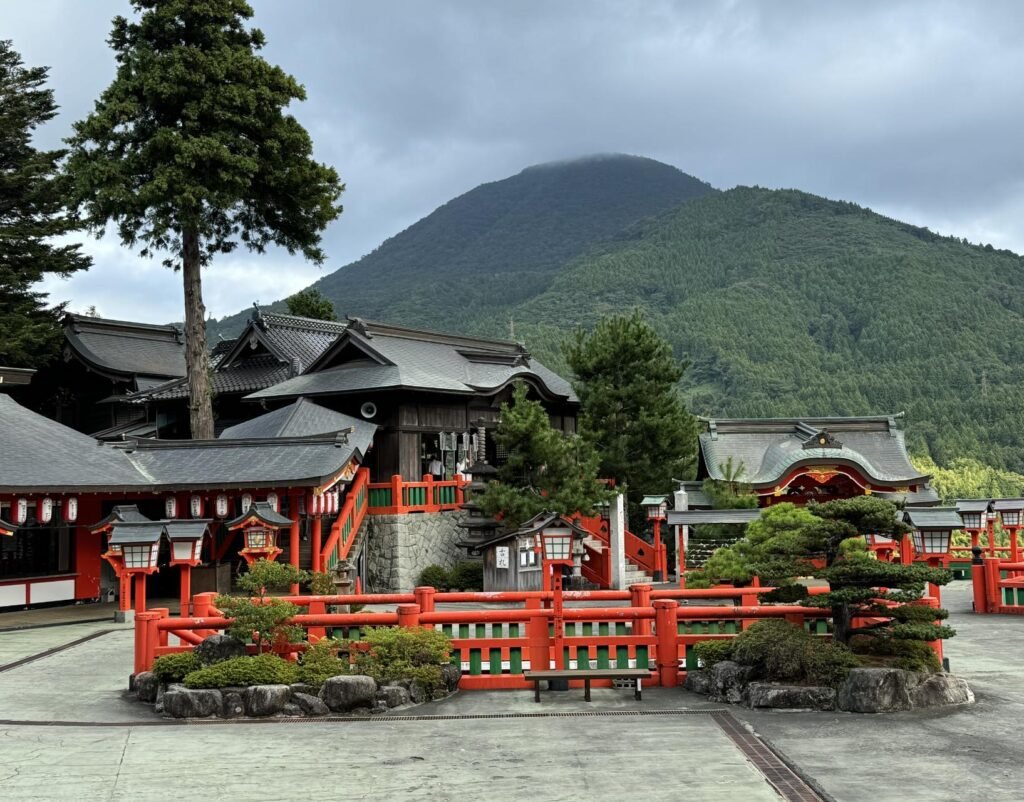
Famed Taikodani Inari Shrine in Tsuwano. Photo by Debbie Stone

Jizo statues. Photo by Debbie Stone
In addition to the shrine, there’s other sites to explore on Miyajima, including a five-storied pagoda, several Buddhist temples, centuries-old stores and houses, museums, etc. You might be curious, as I was, to see many small stone statues shaped like children, adorned with red crocheted caps and grouped along certain pathways. These are jizo. Made in the image of the guardian deity of children and travelers, they are said to have a spiritual power for protection and longevity. Another purpose of these statues is to protect the spirits of children who have passed away. It’s believed that when a child dies before their parents do, they are not able to cross the river to the afterlife and so their days are spent making towers of stones to help gain merit for their parents in their own after life. As for the red caps they wear, the color red is known to expel demons and illness.
Castles are undoubtedly another tourist magnet and there are plenty of them in Japan. They come in all sizes and states of preservation. Some are simply ruins, like Tsuwano Castle. Located on a mountaintop in the town of the same name, the castle dates back to the 13th century. It was continuously used for over 700 years and finally dismantled in 1875 because the government deemed it no longer necessary.
You might wonder why this castle is on the official list of Japan’s top 100 castles. We learned that it’s rare for castle ruins to have their original stone walls, defensive ditches and castle outposts preserved after the main structure is destroyed. Tsuwano, however, is the exception. And it is distinguished for its combination of architectural characteristics from different historical periods.
You’ll glide up the mountain via a chairlift and once atop, get off and hike the trails to see the remains of the castle’s fortifications and watchtowers. At the highest point, you’ll be rewarded with an eye-popping view of Tsuwano. As I stood there, I imagined what life was like for a castle lord, surveying and protecting his village below.
We walked down and on the way back to town, we stopped at the famous mountainside Taikodani Inari Shrine with its tunnel of one thousand vermilion Torii gates. This shrine is one of the five greatest Inari Shrines in Japan and boasts a striking main hall. It was built in the mid-18th century with the intention of protecting the castle against evil spirits. Today, people visit the shrine to pray for good harvest, prosperity and good fortune.
When you visit the shrines and temples in Japan, there’s a respectful etiquette to follow. First, you purify your hands and mouth at the water pavilion using a special ritual with the ladle. Once you reach the altar, toss a coin into the offering box, ring the bell to greet the deity, bow twice, clap twice, say a prayer with your hands together, then bow one more time.
Like many shrines and temples in Japan, you can purchase an Omikuji or fortune paper. The paper gives your overall fortune for the future, ranking it in order of excellent, general, middle, small and bad luck respectively. If you draw bad luck, tie the paper to a designated place on the grounds of the shrine or temple. In this way, you won’t take the bad luck with you.
Hands-on Experiences
Oku Japan’s tours often try to include a few hands-on activities to engage visitors with traditional crafts. It’s one thing to observe others producing art, it’s another to try it yourself. Our group got the opportunity to work with Tatami-beri, the colorful fabric that lines tatami mats. This took place at the Tatami-Beri Factory Shop FLAT. With step-by-step instruction, we added decorative strips to our own small, placemat-size tatami mats, creating a fun souvenir to take home.
Another day, we made our own pottery in Hagi. This well-preserved castle town along the Sea of Japan is a place of great historical and cultural significance. It’s home to five World Heritage Sites related to the birth of Japanese industrialization and is known for its district of beautifully preserved samurai homes (of which we visited several) and white-walled streets dotted with orange trees.

Making pottery in Hagi. Photo by Debbie Stone

Learning to decorate a tatami mat. Photo by Debbie Stone

Finished products! Photo by Debbie Stone
It’s also famous for a type of pottery that bears its name, Hagi-yaki or Hagi ware. Developed over 400 years ago, this pottery continues to be highly-valued and some of the oldest pieces have been declared National Treasures of Japan. It’s distinguished by its earthy texture, due to the type of local clay used.
Each member of our group got to sit at a pottery wheel, and with the assistance of an instructor, we made a piece of Hagi ware. I was nervous initially, as I remembered years ago when I took a short course on pottery making and the frustration I felt using the wheel. This time, however, the instructor patiently worked with me, showing me where to place my hands and how much pressure to apply at the various junctures of the process. The clay felt smooth and pliable and I truly enjoyed the experience of crafting a small vase – another great souvenir.
Drink, Music & Dance
Sake tasting is an experience that many visitors to Japan indulge in. Our group visited Sankan Brewery in Okayama Prefecture. Sankan is an award-winning, traditional Japanese sake brewery dating back to the early 1800s. They use local rice, local water, local people and local techniques to produce their special brand of rice wine. The process takes from “maple leaf season to cherry blossom season.” I would describe Sankan’s sake as very dry and full-bodied.
I also particularly loved the musical and theatrical performances we saw during the trip. The first took place in an historic shipping agency building, dating back to the Edo period. The setting was ideal to listen to a local group play and sing folk songs depicting the area. They used Japanese traditional instruments such as the three-stringed Shamisen and the Shakuhachi, a bamboo flute. Our group was invited to try out these instruments, which proved to be quite challenging, especially the Shakuhachi. No one was able to make a sound come out of this flute, even a woman in our group who was a classically trained flutist.

Local group entertains with Japanese traditional musical instruments. Photo by Debbie Stone

Making okonomiyaki Hiroshima style. Photo by Debbie Stone

Sake tasting. Photo by Debbie Stone

Display of Japanese food. Photo by Debbie Stone
A performance of taiko drumming is always exciting, and the one we watched displayed the talents of both women and men drummers. Taiko was historically used in the battlefields, religious ceremonies, festivals and royal courts. The drums are barrel-shaped with lashed or tacked heads and come in a variety of sizes. When played, the results are powerful and thunderous. Observing these drummers makes you realize just how much energy they’re exerting. It’s definitely a full-body workout!
My favorite performance, however, was in Yunotsu Onsen, a hot-spring town whose waters were discovered more than 1,300 years ago. There we attended a private evening Iwami Kagura show, an ancient Shinto faith dance ritual of the region. The production took place in a Shinto shrine, where it’s traditionally done.
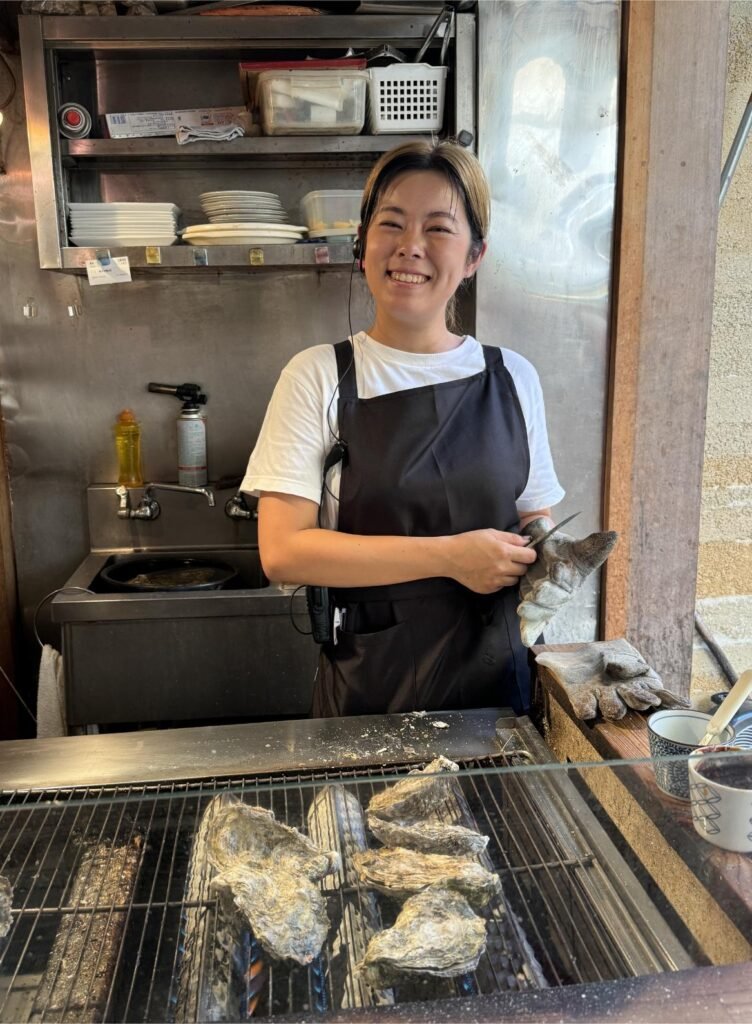
Get your grilled oysters here! Photo by Debbie Stone

Noodles are a staple in Japan. Photo by Debbie Stone
The dancers, accompanied by musicians, re-enacted two age-old stories using props and elaborate costumes. The first concerned Ebisu, the Japanese god of fishermen and luck. A young boy played the part of Ebisu and he was a superb entertainer, making us smile and laugh.
The second dance featured Yamata-no-Orochi, one of the most frightening of all Japan’s mythological monsters. Purportedly, this serpent had eight heads and eight tails. In the dance, a battle between good and evil transpires. The snake grows in size and commands the stage, whipping its heads and tails around in a frenzy, as the dramatic action intensifies. Following the performance, we met the dancers and musicians and got to see the inventive and colorful costumes and props up close.
Ryokans & Minshukus
As for accommodations, we stayed in a variety of properties, including ryokan (traditional Japanese-style inns) and minshuku (Japanese style B&Bs), as well as in more modern, western-style or a blend of western and Japanese style hotels.
Ryokans incorporate elements such as tatami rooms, futon beds, Japanese-style baths and local cuisine. They vary greatly in terms of size, cost and style. Some are small, family-run places with a few rooms, while others are large, almost hotel-like establishments with many rooms.


Garden view. Photo by Debbie Stone

I’m in heaven! A shop for all things matcha. Photo by Debbie Stone
The bathing experience is classic Japanese and a beloved ritual. For those unfamiliar with this tradition, it’s important to follow a protocol. Know that the bathtubs are for soaking, not washing. In larger ryokans and public hot springs, there are communal spa-style baths, segregated by gender. And yes, everyone’s in their birthday suits.
Within the bathing area there are small stools, mirrors, buckets, soap and shampoo. Use the wash cloth you’ve been given to clean yourself. Then completely rinse off before entering the soaking pool(s). After a leisurely soak, get out and dry yourself as much as possible with the same wash cloth, before reentering the locker room.
In smaller facilities, such as the minshuku we stayed in, the bathing tubs are used privately in turn by each guest. You can either reserve a time in advance or just check if they’re available. Note that the bathwater is not changed for each bather, thus they need to keep the water as clean as possible.
Yukata
You’ll get accustomed to wearing a yukata when you’re in these accommodations. Think of it as a cotton robe that can be worn to the baths, to dinner and even to bed. And sometimes, they are worn when walking around town, primarily in hot spring villages. The correct way to wear a yukata is to place the left side against your body, then fold the right side over it and tie the sash around your waist to secure it in place.
At first, it feels a bit weird to eat dinner in a yukata, but then you realize it’s perfectly acceptable, and makes sense, as it’s quite comfortable. No need to dress up!

Performance at shrine. Photo by Debbie Stone
Dining
Dinners at the ryokans are served kaiseki style, which is a traditional, multi-course affair consisting of many little dishes, including sashimi or sliced, raw fish, clear soup, grilled meat or fish, tofu, steamed veggies, a hot-pot, salad, rice, miso soup and Japanese pickles or tsukemono. Dessert is most often fruit or a jelly.
As for Japanese breakfast, it, too, consists of numerous small dishes, like rice, accompanied by dried sea veggies, miso soup, grilled fish and tsukemono, plus a salty plum or umeboshi and sometimes natto, or fermented soybeans.

The table is set for dinner. Photo by Debbie Stone
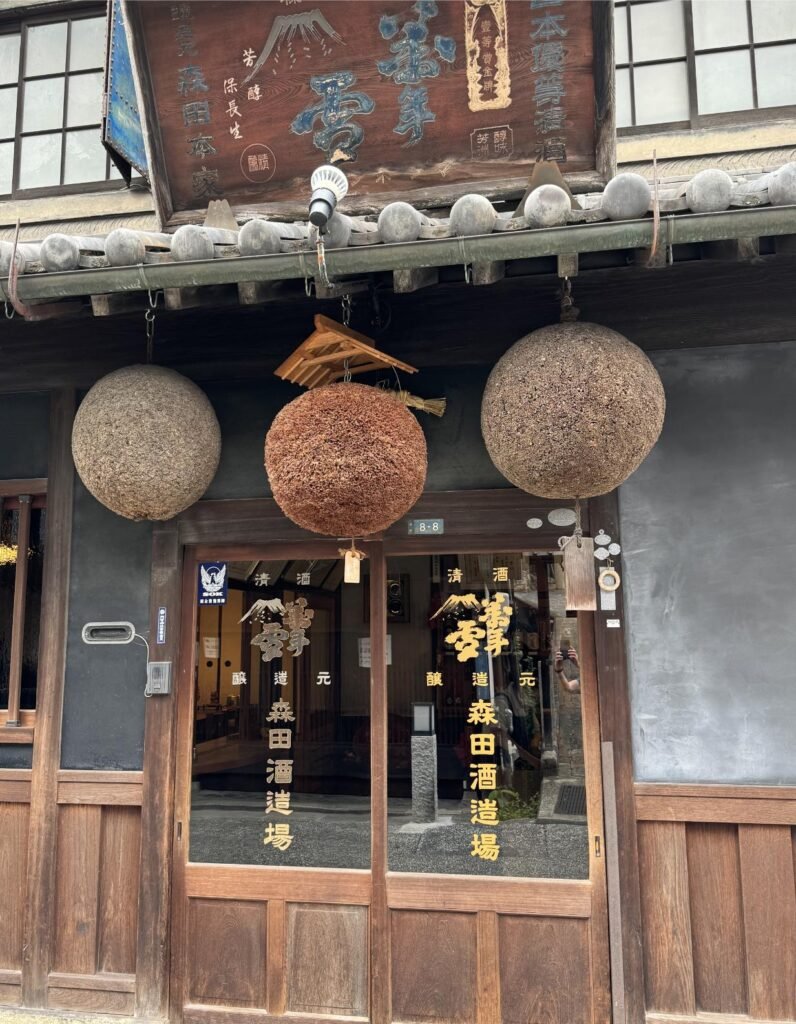
Sake shop. Photo by Debbie Stone

Yes, there’s even Lego in the shape of Japanese food. Photo by Debbie Stone
Outside the ryokan meals, there’s a whole other world of Japanese cuisine to try, from sushi and yakitori (grilled chicken on a skewer) to okonomiyaki (a savory pancake), tempura and the ubiquitous noodles – ramen and soba, either hot or cold. The variety of munchies and sweets is also extensive. I’m partial to Japanese rice crackers, anything with azuki or red bean paste in it, mochi and everything matcha. There are stores completely devoted to matcha products and I frequented quite a few to get my fix of matcha ice cream, matcha brownies, matcha smoothies, matcha buns, matcha crackers…you get the picture!
Visiting the small towns and villages in this region of Japan made this trip special. And in some of the places, we were the only tourists. I treasured the peace and quiet, and the slow pace these locations offered, away from the crowds. The locals were always welcoming and helpful. And despite the language barrier, which is often more pronounced in rural areas, we were able to communicate using a few words, gestures and many smiles. This is something I’ve experienced over and over again as I explore the world. It’s one of the treasures of travel.

Picturesque stone bridge. Photo by Debbie Stone

Yukatas can be worn outdoors, especially in hot spring villages. Photo by Debbie Stone

Ryokan room. Photo by Debbie Stone
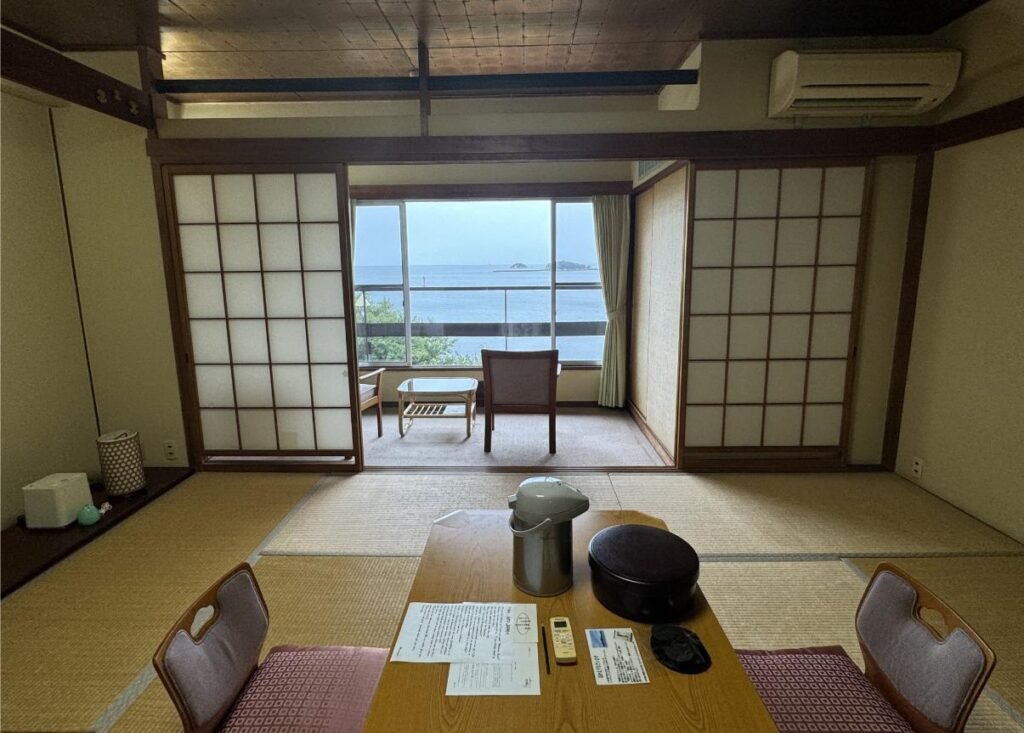
Ryokan room with a view. Photo by Debbie Stone


































